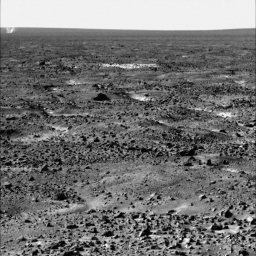
|
Martian Dust Devil Movie, Phoenix Sol 104
- Click the image above for a larger view
 Movie Download Options
Movie Download Options- Full-Res JPEG (1024 x 1024) (235.1 kB)
- Full-Res TIFF (1024 x 1024) (1.1 MB)
Caption:
The Surface Stereo Imager on NASA's Phoenix Mars Lander caught this dust devil in action west of the lander in four frames shot about 50 seconds apart from each other between 11:53 a.m. and 11:56 a.m. local Mars time on Sol 104, or the 104th Martian day of the mission, Sept. 9, 2008.
Dust devils have not been detected in any Phoenix images from earlier in the mission, but at least six were observed in a dozen images taken on Sol 104.
Dust devils are whirlwinds that often occur when the Sun heats the surface of Mars, or some areas on Earth. The warmed surface heats the layer of atmosphere closest to it, and the warm air rises in a whirling motion, stirring dust up from the surface like a miniature tornado.
The dust devil visible in this sequence was about 1,000 meters (about 3,300 feet) from the lander when the first frame was taken, and had moved to about 1,700 meters (about 5,600 feet) away by the time the last frame was taken about two and a half minutes later. The dust devil was moving westward at an estimated speed of 5 meters per second (11 miles per hour), which is similar to typical late-morning wind speed and direction indicated by the telltale wind gauge on Phoenix.
This dust devil is about 5 meters (16 feet) in diameter. This is much smaller than dust devils that have been observed by NASA's Mars Exploration Rover Spirit much closer to the equator. It is closer in size to dust devils seen from orbit in the Phoenix landing region, though still smaller than those.
The image has been enhanced to make the dust devil easier to see. Some ofthe frame-to-frame differences in the appearance of foreground rocks is because each frame was taken through a different color filter.
Background Info:
The Phoenix Mission is led by the University of Arizona, Tucson, on behalf of NASA. Project management of the mission is by NASA's Jet Propulsion Laboratory, Pasadena, Calif. Spacecraft development is by Lockheed Martin Space Systems, Denver.
Photojournal Note: As planned, the Phoenix lander, which landed May 25, 2008 23:53 UTC, ended communications in November 2008, about six months after landing, when its solar panels ceased operating in the dark Martian winter.
Cataloging Keywords:
| Name | Value | Additional Values |
|---|---|---|
| Target | Mars | |
| System | ||
| Target Type | Planet | |
| Mission | Phoenix | Mars Exploration Rover (MER) |
| Instrument Host | Phoenix Lander | Spirit (MER-A) |
| Host Type | Lander | Rover |
| Instrument | Solid-State Imaging (SSI) | |
| Detector | ||
| Extra Keywords | Atmosphere, Dust, Grayscale, Movie | |
| Acquisition Date | ||
| Release Date | 2008-09-14 | |
| Date in Caption | ||
| Image Credit | NASA/JPL-Caltech/University of Arizona/Texas A&M University | |
| Source | photojournal.jpl.nasa.gov/catalog/PIA11155 | |
| Identifier | PIA11155 | |
